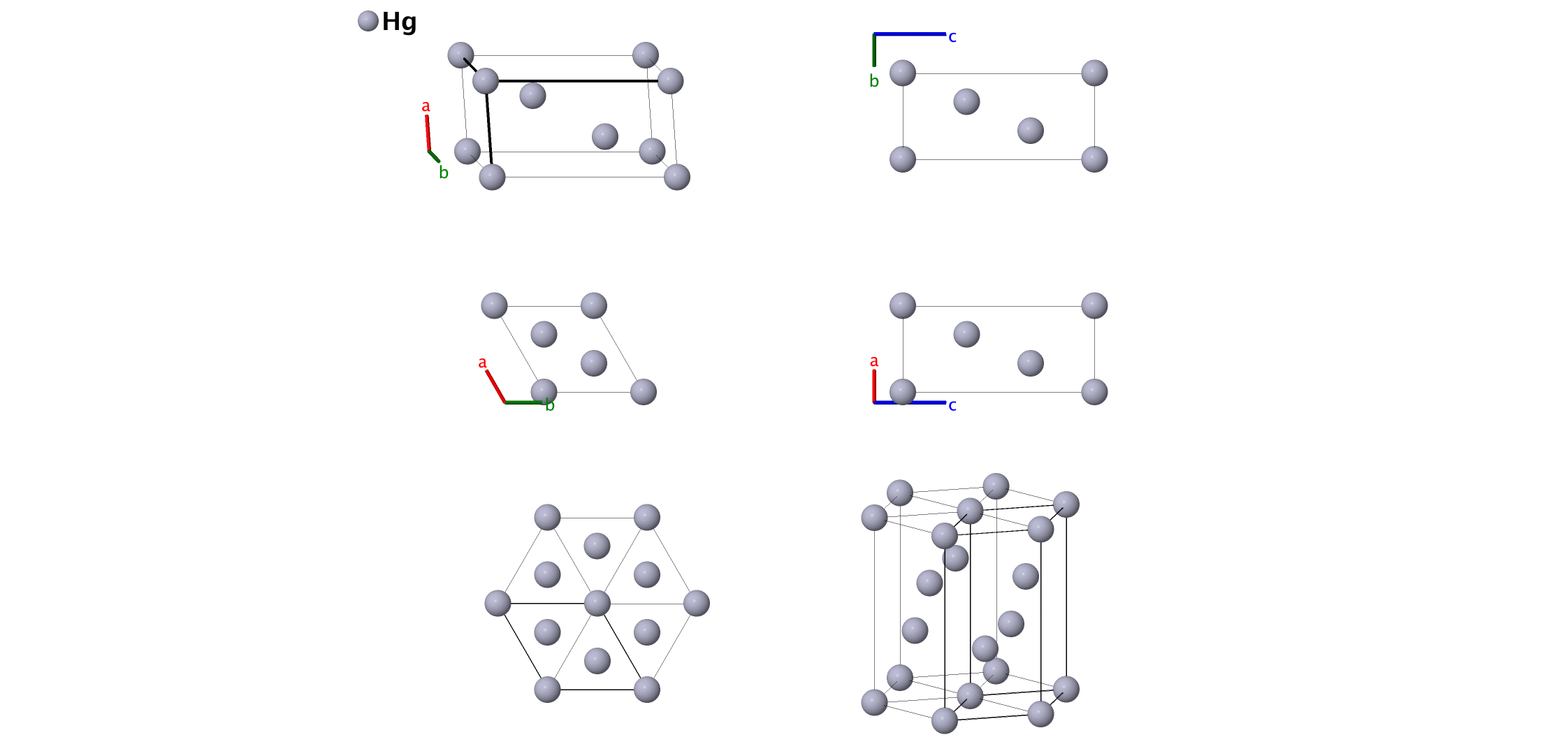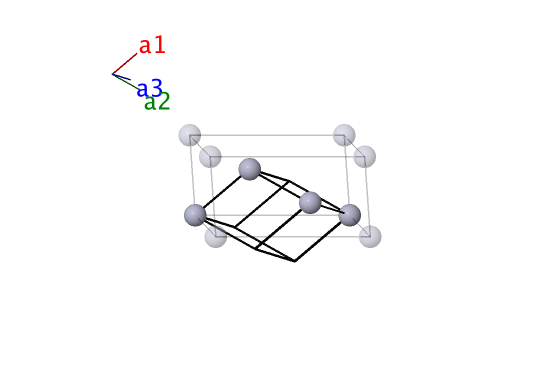
$\alpha$–Hg (A10) Structure: A_hR1_166_a
| Prototype | : | $\alpha$–Hg |
| AFLOW prototype label | : | A_hR1_166_a |
| Strukturbericht designation | : | $A10$ |
| Pearson symbol | : | hR1 |
| Space group number | : | 166 |
| Space group symbol | : | $\mbox{R}\bar{3}\mbox{m}$ |
| AFLOW prototype command | : | aflow --proto=A_hR1_166_a [--hex] --params=$a,c/a$ |
- This rhombohedral structure becomes cubic at various values of $c/a$ (or $\alpha$) to wit, \[ \begin{array}{ccc} \mbox{$\textbf{$c/a$}$} & \mathbf{\alpha} & \mbox{$\textbf{Cubic Lattice}$} \\ \sqrt{6} & 60^{o} & \href{A_cF4_225_a.html}{\mbox{Face-Centered Cubic}} \\ \sqrt{\frac{3}{2}} & 90^{o} & \href{A_cP1_221_a.html}{\mbox{Simple Cubic}} \\ \sqrt{\frac{3}{8}} & 109.47^{o} & \href{A_cI2_229_a.html}{\mbox{Body-Centered Cubic}} \\ \end{array} \]Note that $\beta$–Po (A_hR1_166_a, $\beta$–Po) and $\alpha$–Hg (A_hR1_166_a, $\alpha$–Hg) have the same AFLOW prototype label. They are generated by the same symmetry operations with different sets of parameters (––params) specified in their corresponding CIF files. Experimentally, $\beta$–Po (Ai) has c/a near 1, or $\alpha$ > 90$^{o}$, while $\alpha$–Hg (A10) has c/a near 2, or $\alpha$ < 90$^{o}$. Hexagonal settings of this structure can be obtained with the option ––hex.
Rhombohedral primitive vectors:
\[
\begin{array}{ccc}
\mathbf{a}_1 & = & ~ \frac12 \, a \, \mathbf{\hat{x}} - \frac{1}{2\sqrt{3}} \, a \, \mathbf{\hat{y}} + \frac13
\, c \, \mathbf{\hat{z}} \\
\mathbf{a}_2 & = & \frac{1}{\sqrt{3}} \, a \, \mathbf{\hat{y}} + \frac13 \, c \, \mathbf{\hat{z}} \\
\mathbf{a}_3 & = & - \frac12 \, a \, \mathbf{\hat{x}} - \frac{1}{2\sqrt{3}} \, a \, \mathbf{\hat{y}} + \frac13
\, c \, \mathbf{\hat{z}} \\
\end{array}
\]
Basis vectors:
\[ \begin{array}{ccccccc} & & \mbox{Lattice Coordinates} & & \mbox{Cartesian Coordinates} &\mbox{Wyckoff Position} & \mbox{Atom Type} \\ \mathbf{B}_{1} & =&0 \, \mathbf{a}_{1} + 0 \, \mathbf{a}_{2} + 0 \, \mathbf{a}_{3} & =&0 \mathbf{\hat{x}} + 0 \mathbf{\hat{y}} + 0 \mathbf{\hat{z}} & \left(1a\right) & \mbox{Hg} \\ \end{array} \]References
- C. S. Barrett, The structure of mercury at low temperatures, Acta Cryst. 10, 58–60 (1957), doi:10.1107/S0365110X57000134.
Found in
- J. Donohue, The Structure of the Elements (Robert E. Krieger Publishing Company, Malabar, Florida, 1982)., pp. 231-233.
